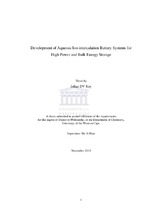| dc.description.abstract | Aqueous ion-intercalation batteries (AIB’s) have the potential to provide both high
power for hybrid-electric transport, and low cost bulk energy storage for electric grid supply. However, a major setback to AIB development is the instability of suitable ionintercalation anode material in aqueous electrolyte. To counter this problem, the use of activated carbon (AC) (a supercapacitor anode) paired against the low cost ionintercalation cathode spinel LiMn2O4 (LMO) provides a stable alternative. This thesis comprises two novel areas of investigation concerning: (1) the development of the AC/LMO cell for high power applications, and (2) the introduction of PbSO4 as a high capacity alternative anode material paired against LMO for low cost bulk energy storage. The study on AC/LMO explores the electrode combination’s practical specific energy and power capability at high P/E (power to energy ratio) of 50:1 suitable for hybrid electric vehicle batteries. To study the relationship between electrode material loading density, active material performance, and current collector mass contribution, a specially designed cell was constructed for galvanic cycling of different thicknesses of electrode. Between a loading density range of 25 – 100 mg, ~50 mg of total active material between two 1 cm2 current collectors produced the highest 50:1 P/E ratio values of 4 Wh/kg and 200 W/kg, constituting a 4-fold reduction of the active material values of thin films at 50:1 P/E. The cycling potentials of the individual electrodes revealed that doublings of electrode film loading density increased the LMO electrode’s
polarization and voltage drop to similar levels as doublings in applied current density. However, by increasing the charging voltage from 1.8 V to 2.2 V, 6 Wh/kg and 300 W/kg was obtainable with minimal loss of energy efficiency. Finally a large-format cell of a calculated 3 Ah capacity at 50:1 P/E was constructed and tested. The cell produced ~60% of the anticipated capacity due to a suspected high level of resistance in the electrode contact points. The overall conclusion to the study was that AC/LMO holds promise for high power applications, and that future use of higher rate capability forms of LMO offers a promising avenue for further research.
v The second part of this thesis presents the development of a novel cell chemistry,
PbSO4/LMO, that has yet to be reported elsewhere in existing literature. The cell uses aqueous pH 7, 1 M, Li2SO4 electrolyte, and forms an electrode coupling where the PbSO4 anode charge/discharge is analogous to that in Pb-acid batteries. The average discharge voltage of the cell was 1.4 V and formed a flat charge/discharge plateau. The use of a low cost carbon coating method to encapsulate PbSO4 microparticles had a marked improvement on cell performance, and compared to uncoated PbSO4 improved both rate capability and specific capacity of the material. The active materials of the carbon-coated PbSO4/LMO cell produced a specific energy 51.1 Wh/kg, which, if a 65% yield is possible for a practical cell format, equals 38.4 Wh/kg, which is 15 Wh/kg higher than AC/LMO bulk storage cells at 23 Wh/kg, but lower than Pb-acid batteries at ~25-50 Wh/kg. Interestingly, the specific capacity of PbSO4 was 76 mAh/g compared to 100 mAh/g in Pb-acid cells. The predicted cost of the cell, providing a 65% value of the active material specific energy for a practical cell can be realized, is on par with Pb-acid battery technology and, importantly, uses 2.3 × less Pb/kWh. The cycling stability achieved thus far is promising, but will require testing over comparable cycle life periods to commercial batteries, which could be anywhere between 5 – 15 years. | en_US |

